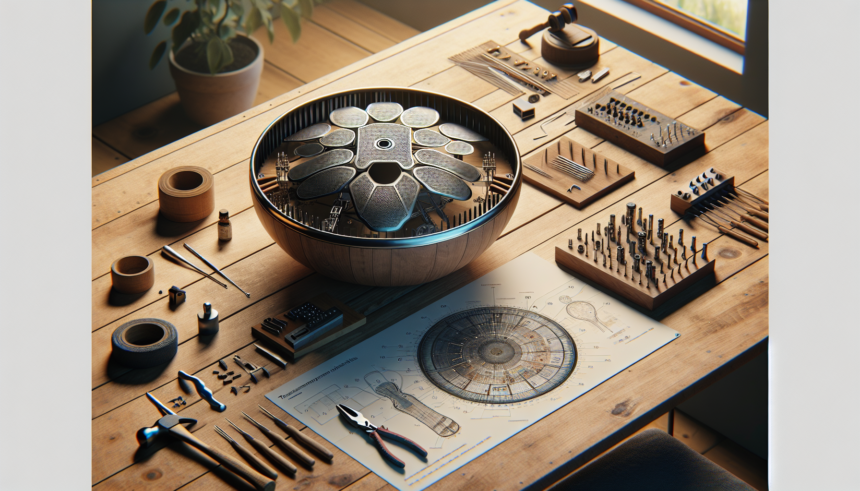<!DOCTYPE html>
<html lang="en">
<head>
<meta charset="UTF-8">
<meta name="viewport" content="width=device-width, initial-scale=1.0">
<title>Troubleshooting Common Handpan Issues</title>
</head>
<body>
<p>The handpan is a unique and increasingly popular instrument known for its ethereal sound and intuitive playability. Like any instrument, however, it can experience issues that affect both its sound and the playing experience. In this article, we'll explore some common issues faced by handpan players and provide guidance on troubleshooting and solving these problems to restore the instrument to its optimal condition.</p>
<h2>Understanding Your Handpan</h2>
<p>Before diving into troubleshooting, it's essential to understand the structure of a handpan. The instrument consists of two metal shells, usually made of steel, with a central note surrounded by a series of ready-tuned notes on the top shell. The handpan's sound is produced by striking the steel, which resonates to produce the unique tones associated with the instrument.</p>
<p>Each note area is carefully crafted and requires specific tuning. Factors such as temperature changes, humidity, or physical damage can affect its performance, leading to potential issues that may require attention.</p>
<h2>Common Handpan Issues and Solutions</h2>
<h3>1. Detuning</h3>
<p>One of the most common issues faced by handpan players is detuning. It can occur due to various reasons such as temperature changes, playing too aggressively, or physical damage to the instrument. Detuning alters the intended pitch of the notes, which can be frustrating for musicians who rely on consistent sound quality.</p>
<p><strong>Solution:</strong> Re-tuning a handpan usually requires the skill of a professional tuner. It involves carefully hammering the note areas to adjust their pitches back to the original tuning. While some experienced players may attempt to re-tune their instrument, it is generally advisable to consult a professional to avoid further damage.</p>
<h3>2. Surface Scratches and Dents</h3>
<p>Given that handpans are made of metal, they are prone to scratches and dents. These imperfections can affect both the aesthetics and acoustics of your handpan. Superficial scratches may not alter the sound significantly, but deeper dents might impact the resonance and pitch of specific notes.</p>
<p><strong>Solution:</strong> For minor scratches, a microfiber cloth can help polish the surface. However, if the surface damage is more pronounced, it may need to be addressed by a professional smith. Dents, in particular, can be tricky. A skilled tuner can adjust these areas without altering the overall tone of the handpan.</p>
<h3>3. Rust and Corrosion</h3>
<p>Handpans are susceptible to rust and corrosion, especially if they're exposed to moisture without adequate care. This issue not only affects the sound quality but can also damage the structural integrity of the handpan.</p>
<p><strong>Solution:</strong> Regular maintenance is crucial to prevent rust and corrosion. This includes wiping down the instrument after each use to remove any moisture and applying oil occasionally to create a protective barrier. If rust forms, gently remove it using a rust remover suitable for metals, while being careful not to damage the instrument.</p>
<h3>4. Buzzing or Rattling Sounds</h3>
<p>Sometimes, handpans may produce unexpected buzzing or rattling sounds. This could be due to loose debris trapped inside or issues with the instrument's internal construction.</p>
<p><strong>Solution:</strong> Inspect the handpan to ensure no loose parts or foreign objects are inside. If the buzzing persists and you suspect internal problems, it may require the attention of a professional who can disassemble and inspect the handpan's interior.</p>
<h3>5. Touch Sensitivity</h3>
<p>Touch sensitivity refers to the amount of force needed to produce a sound on a handpan. Variations in sensitivity can result from changes in the instrument's structural tension or damage to the note areas.</p>
<p><strong>Solution:</strong> If you notice a sudden change in sensitivity, it might indicate the need for re-tuning or repair. It's advisable to consult a professional handpan tuner who can assess the instrument and make necessary adjustments.</p>
<h2>Caring for Your Handpan</h2>
<p>Effective handpan care can prevent many common issues and extend the life of your instrument. Here are some care tips:</p>
<ul>
<li><strong>Storage:</strong> Keep your handpan in a dry, controlled environment to prevent rust and detuning caused by humidity and temperature fluctuations.</li>
<li><strong>Cleansing:</strong> Use a soft, damp cloth to clean your handpan after playing, ensuring any sweat or oil from your hands is removed.</li>
<li><strong>Protective Oiling:</strong> Apply a light coat of oil, such as coconut or specific handpan oil, to the surface of the handpan regularly to protect against corrosion.</li>
<li><strong>Transport and Handling:</strong> Always use a padded bag or case when transporting your handpan, and handle it with care to avoid drops or knocks that could cause damage.</li>
</ul>
<h2>Conclusion</h2>
<p>The handpan, with its unique acoustic properties and visual appeal, is a cherished instrument for many musicians. Awareness and attentive care can go a long way in preserving its quality and performance, mitigating many common issues like detuning, rust, and physical damage.</p>
<p>In most cases, professional guidance and services are recommended for addressing technical problems such as re-tuning or dent correction. Taking precautionary measures to care for your handpan can significantly reduce the need for repairs and ensure that it continues to produce its signature sound, providing you with a rewarding musical experience.</p>
<h2>Frequently Asked Questions (FAQs)</h2>
<h3>Q1: Can I re-tune the handpan by myself at home?</h3>
<p>A1: While it's technically possible, it is generally recommended to leave re-tuning to professional handpan tuners. Attempting it without experience can lead to further detuning or damage to the instrument.</p>
<h3>Q2: What types of oil should I use for handpan maintenance?</h3>
<p>A2: Use a non-corrosive oil like coconut oil or specific oils designed for handpan maintenance. This will help create a protective barrier against rust without damaging the surface of the instrument.</p>
<h3>Q3: How often should I clean and oil my handpan?</h3>
<p>A3: Clean your handpan regularly, ideally after each playing session, and oil it every few months, or as needed based on usage and environmental conditions, to prevent rust and maintain its sound quality.</p>
<h3>Q4: What should I do if my handpan starts to rust?</h3>
<p>A4: If rust appears, gently cleanse the area with a rust remover safe for metals. Be careful not to scrub excessively, as it may damage the surface. Prevention is key, so regular maintenance and proper storage are essential.</p>
<h3>Q5: How can I prevent my handpan from detuning?</h3>
<p>A5: Avoid exposing your handpan to extreme temperatures or humidity and handle it with care. Regular maintenance, proper storage, and gentle playing can help maintain its tuning stability.</p>
</body>
</html>Troubleshooting Common Handpan Issues

Leave a comment




